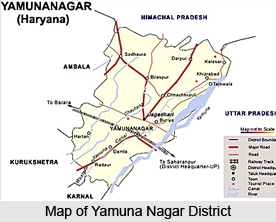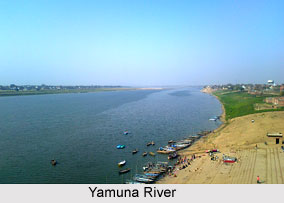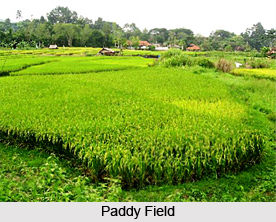 Yamuna Nagar District is one of the 21 administrative districts of Haryana. This district came into existence on 1st of November, 1989. Total area covered by Yamuna Nagar District is 1756 sq kms. Large part of the district lies under the Shivalik foothills. Yamuna Nagar is the district headquarters. Before being named Yamuna Nagar it was known as Abdulahpur. Pre-independence, it was a small village with low population. After the partition of the country, many refugees came to this area. Thus, the area which was allocated to the refugees later developed into the model town area of Yamuna Nagar.
Yamuna Nagar District is one of the 21 administrative districts of Haryana. This district came into existence on 1st of November, 1989. Total area covered by Yamuna Nagar District is 1756 sq kms. Large part of the district lies under the Shivalik foothills. Yamuna Nagar is the district headquarters. Before being named Yamuna Nagar it was known as Abdulahpur. Pre-independence, it was a small village with low population. After the partition of the country, many refugees came to this area. Thus, the area which was allocated to the refugees later developed into the model town area of Yamuna Nagar.
Location of Yamuna Nagar District
Yamuna Nagar District is situated at 30 degree 17 minutes north latitude and 77 degree to 77 degree 53 minutes east longitude. Yamuna Nagar District has an average elevation of 255 metres (836 feet) above mean sea level. Yamuna Nagar District is bounded by Himachal Pradesh in the north, by Uttar Pradesh in the east, in the south east by Kurukshetra District, in the south east by Karnal District and by Ambala District in the east.
Geography of Yamuna Nagar District
Yamuna Nagar District falls in geological domain in the Shivalik hills which are confined to the northern part of Haryana. Yamuna Nagar District has subtropical continental monsoon climate that is characterised by seasonal rhythm, hot summers, cool winter, unreliable rainfalls and great variation in temperature. In winters frost sometime occurs during December and January. Yamuna Nagar District experiences extreme climate conditions. May and June are the hottest months while December and January are the coldest. Maximum temperature on average goes as high as 44 degree Celsius in the summer season. Temperature starts rising steadily from February onwards till the on set of monsoon.
 The average annual rainfall of the district comes out to be 970.33. The important rivers of the district are Yamuna River, Sarasvati, Chautang, Rakshi Rivers, etc. Yamuna River enters the district from its northeastern corner through a narrow corridor in the Shivalik. It is a perennial river. Generally, the slope of Yamuna Nagar District is from north-east to south-west, in which direction most of rivers flow down. The soils in the district are mainly loamy in nature. The underground water in the district is suitable for domestic and irrigation purposes. The district has favorable climate for the growth of rich vegetation due to reasonably good rainfall and elevation. Tropical dry deciduous forests and sub-tropical forests are found here. Yamuna Nagar District of Haryana receives second highest rainfall after Panchkula District.
The average annual rainfall of the district comes out to be 970.33. The important rivers of the district are Yamuna River, Sarasvati, Chautang, Rakshi Rivers, etc. Yamuna River enters the district from its northeastern corner through a narrow corridor in the Shivalik. It is a perennial river. Generally, the slope of Yamuna Nagar District is from north-east to south-west, in which direction most of rivers flow down. The soils in the district are mainly loamy in nature. The underground water in the district is suitable for domestic and irrigation purposes. The district has favorable climate for the growth of rich vegetation due to reasonably good rainfall and elevation. Tropical dry deciduous forests and sub-tropical forests are found here. Yamuna Nagar District of Haryana receives second highest rainfall after Panchkula District.
Demography of Yamuna Nagar District
As per 2001 Census, total population of Yamuna Nagar District is 189,587. Male population accounts for around 54 percent and female population is near about 46 percent of the total population. Yamuna Nagar District has an average literacy rate of 74 percent, higher than the national average of 59.5 percent. Male literacy rate in the district is 77 percent, and female literacy rate is around 70 percent. In Yamuna Nagar District, 12 percent of the population is under 6 years of age.
Administration of Yamuna Nagar District
Yamuna Nagar District comprises one sub division that is Jagadhri and two tehsils namely Jagadhri and Chhachhrauli. Administrative set-up of Yamuna Nagar District includes four sub tehsils namely Radaur, Bilaspur, Sadhaura and Mustafabad. There are two Municipal Councils - Yamuna Nagar and Jagadhri and six Development Blocks namely, Jagadhri, Bilaspur, Sadhaura, Chhachhrauli, Radaur and Mustafabad. Yamuna Nagar District also consists of 655 villages out of which 629 inhabited and 26 uninhabited. This district falls in two Lok Sabha constituencies - Kurukshetra and Ambala and covered by five assembly constituencies namely Jagadhri, Radaur, Sadhaura, Yamuna Nagar and Chhachhrauli. The Deputy Commissioner is the overall in-charge of the general administration in the district. He is assisted by a number of officers belonging to Haryana Civil Service and other Haryana state services.
 Economy of Yamuna Nagar District
Economy of Yamuna Nagar District
Economy of Yamuna Nagar District is mainly based on agriculture and is agrarian in character. Total cultivated area of the district is around 126442 hectares. Cultivated area under sugarcane, paddy and wheat in the district is 32 percent, 31 percent and 37 percent respectively of the total area. Agro forestry is another important feature of the economy of Yamuna Nagar District. The major Kharif crops cultivated here are sugarcane, paddy and maize while the minor crops are wheat, gram, lentil and oilseeds. The cropping pattern in the district is mainly sugarcane, wheat and paddy. Total irrigated area of Yamuna Nagar District is 106323 hectares. Out of which under canal irrigation is 3500 hectares and is served by Western Yamuna Canal.
Large industries like Shri Gopal Paper Mills and Saraswati Sugar Mills (that is the biggest sugar mill in Asia) are located in Yamuna Nagar. Moreover, Panchmukhi Hanuman Mandir is one of the main tourist attractions of Yamuna Nagar District.






